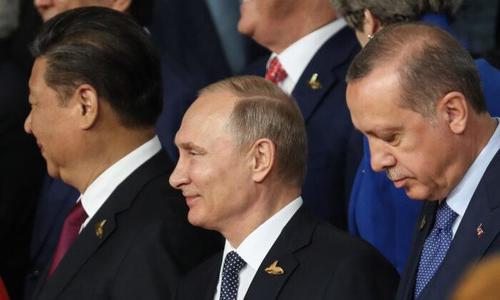Washington’s escalating hybrid warfare operations against Ethiopia may have cost the United States its strategic influence over the globally-vital Red Sea/Suez sea lanes.

The U.S. abandonment of Ethiopia has forced its government to seek allies and protection elsewhere, and Russia, China, and Turkey have rushed in to fill the power vacuum.
The now-open hostility of the Biden administration toward Ethiopia was rationalized as being supportive of Egypt’s position as the United States’ preferred partner in the region, controlling the Suez Canal. Washington also justifies its hostility on claims—widely discredited by the evidence—of Ethiopian “human rights violations” in its fight against the Tigray People’s Liberation Front (TPLF) marxist insurgency. But it was the TPLF which began the war surging into the neighboring Ethiopian Amhara and Afar regions, causing millions of refugees.
And despite the U.S. efforts to please Cairo, Beijing and Moscow have also improved their positions with the Egyptian government.
As a result, the Ethiopian government, which had seen Washington as its preferred partner, was forced to reopen talks with China—which the government of Prime Minister Abiy Ahmed Ali had essentially rejected on taking office in 2018—as well as Russia and Turkey. Turkey had until this point been regarded as a threat to Ethiopia, given that it had been funding Islamist insurgents in Ethiopia in recent years.
To improve its defense position, the Ethiopian National Defense Force has been acquiring significant numbers of unmanned aerial combat vehicles (UCAVs) from China, Turkey, and Iran, and large amounts of weapons and ammunition from Russia, Belarus, and the United Arab Emirates. Russia has been moving Sukhoi Su-27S combat aircraft into the Ethiopian Air Force.
The U.S. moves support Egypt’s longstanding rivalry with Ethiopia—a rivalry which has not been reciprocated—out of fear that a strong and united Ethiopia could dominate the lower Red Sea and jeopardize maritime traffic coming into and from Egypt’s Suez Canal. Egypt has also alleged that Ethiopia, the source of the Blue Nile, was restricting Nile water flows to Egypt. This was proven to be a false claim, too, although Egypt does face an increasing water shortage because of its growing population. Cairo, however, needs a scapegoat.
China and Russia have been able to prove that they have real leverage in the region by resisting U.S. attempts to have the United Nations Security Council authorize military intervention against Ethiopia. The U.S. move was to help the TPLF and the equally violent—avowedly genocidal—Oromo Liberation Front (OLF) to break up Ethiopia.
Beijing and Moscow gained considerable gratitude in Addis Ababa by using their veto powers in the Security Council to delay or block Washington’s plans. And Beijing already maintains a significant military base in Ethiopia’s neighbor, Djibouti, and built the new Djibouti-Addis Ababa rail link.

Chinese People’s Liberation Army personnel attend the opening ceremony of China’s new military base in Djibouti on Aug. 1, 2017. (STR/AFP via Getty Image)
In mid-October, Washington escalated plans for economic sanctions against Ethiopia for refusing to allow “U.S. aid” convoys to be routed through the Ethiopian capital to the TPLF. Addis Ababa quickly discovered that the “U.S. aid” convoys were going merely to support the TPLF’s military operations against both the Tigrayan population and other Ethiopians.
Hundreds of “aid convoys” were reaching the TPLF, but the trucks never returned to the capital; they were diverted to be used by the TPLF to aid its mobile warfare, now well-entrenched in the Amara and Afar regions.
Far from being embattled, the TPLF has been engaging in large-scale, formal offensive military operations and causing what is genuinely a humanitarian crisis, with massive casualties and an estimated 2 million refugees. The World Heritage city of Lalibela in Amhara Region has been occupied for several months by TPLF forces, who were trained and armed by the United States under the Obama administration.
Long-serving U.N. officials in Ethiopia have complained that, with the U.S. pressure, new U.N. officials have been shipped into the country and have been promoting the U.S.-TPLF line against the advice of the more experienced U.N. country team. Meanwhile, Ethiopian government forces had, by the second week of October, begun an offensive against the TPLF, utilizing China’s Wing Loong II (CJ-2) MALE (Medium-Altitude, Long-Endurance) UCAVs, which had been shipped in urgently from Chengdu to the Harar Meda Air Base in Ethiopia, not far from the fighting in the Afar and Amhara regions. The CJ-2s can carry 420 kg of ordnance, including precision weapons.
Ethiopia has also acquired Turkish Bayraktar TB2 UCAVs, as well as Iranian UAVs.
It does not appear as though the U.S. escalation of political and economic warfare against Ethiopia will abate as long as the Biden administration’s present State Department team is in place. State Department sources admit privately that they are using the same playbook against Ethiopia as they used during the Clinton administration against Serbia in the 1990s. But the United States was then strategically far stronger, and China, Russia, and Turkey were far weaker.




